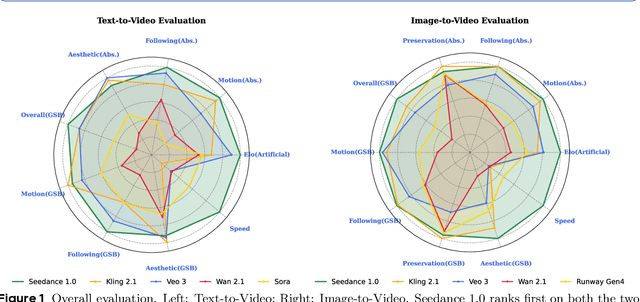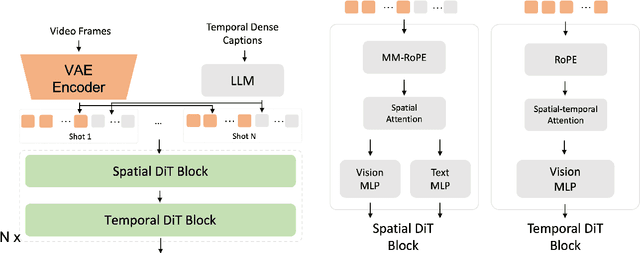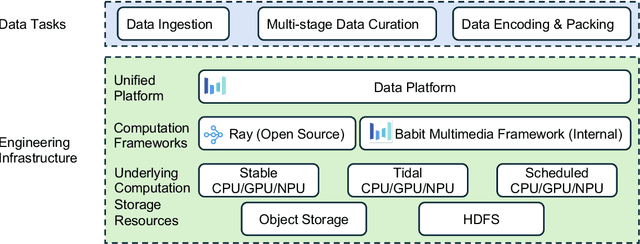Li Sun
Wireless Channel Foundation Model with Embedded Noise-Plus-Interference Suppression Structure
Sep 19, 2025Abstract:Wireless channel foundation model (WCFM) is a task-agnostic AI model that is pretrained on large-scale wireless channel datasets to learn a universal channel feature representation that can be used for a wide range of downstream tasks related to communications and sensing. While existing works on WCFM have demonstrated its great potentials in various tasks including beam prediction, channel prediction, localization, etc, the models are all trained using perfect (i.e., error-free and complete) channel information state (CSI) data which are generated with simulation tools. However, in practical systems where the WCFM is deployed, perfect CSI is not available. Instead, channel estimation needs to be first performed based on pilot signals over a subset of the resource elements (REs) to acquire a noisy version of the CSI (termed as degraded CSI), which significantly differs from the perfect CSI in some real-world environments with severe noise and interference. As a result, the feature representation generated by the WCFM is unable to reflect the characteristics of the true channel, yielding performance degradation in downstream tasks. To address this issue, in this paper we propose an enhanced wireless channel foundation model architecture with noise-plus-interference (NPI) suppression capability. In our approach, coarse estimates of the CSIs are first obtained. With these information, two projection matrices are computed to extract the NPI terms in the received signals, which are further processed by a NPI estimation and subtraction module. Finally, the resultant signal is passed through a CSI completion network to get a clean version of the CSI, which is used for feature extraction. Simulation results demonstrated that compared to the state-of-the-art solutions, WCFM with NPI suppression structure achieves improved performance on channel prediction task.
MoSE: Unveiling Structural Patterns in Graphs via Mixture of Subgraph Experts
Sep 11, 2025Abstract:While graph neural networks (GNNs) have achieved great success in learning from graph-structured data, their reliance on local, pairwise message passing restricts their ability to capture complex, high-order subgraph patterns. leading to insufficient structural expressiveness. Recent efforts have attempted to enhance structural expressiveness by integrating random walk kernels into GNNs. However, these methods are inherently designed for graph-level tasks, which limits their applicability to other downstream tasks such as node classification. Moreover, their fixed kernel configurations hinder the model's flexibility in capturing diverse subgraph structures. To address these limitations, this paper proposes a novel Mixture of Subgraph Experts (MoSE) framework for flexible and expressive subgraph-based representation learning across diverse graph tasks. Specifically, MoSE extracts informative subgraphs via anonymous walks and dynamically routes them to specialized experts based on structural semantics, enabling the model to capture diverse subgraph patterns with improved flexibility and interpretability. We further provide a theoretical analysis of MoSE's expressivity within the Subgraph Weisfeiler-Lehman (SWL) Test, proving that it is more powerful than SWL. Extensive experiments, together with visualizations of learned subgraph experts, demonstrate that MoSE not only outperforms competitive baselines but also provides interpretable insights into structural patterns learned by the model.
HyperTASR: Hypernetwork-Driven Task-Aware Scene Representations for Robust Manipulation
Aug 26, 2025Abstract:Effective policy learning for robotic manipulation requires scene representations that selectively capture task-relevant environmental features. Current approaches typically employ task-agnostic representation extraction, failing to emulate the dynamic perceptual adaptation observed in human cognition. We present HyperTASR, a hypernetwork-driven framework that modulates scene representations based on both task objectives and the execution phase. Our architecture dynamically generates representation transformation parameters conditioned on task specifications and progression state, enabling representations to evolve contextually throughout task execution. This approach maintains architectural compatibility with existing policy learning frameworks while fundamentally reconfiguring how visual features are processed. Unlike methods that simply concatenate or fuse task embeddings with task-agnostic representations, HyperTASR establishes computational separation between task-contextual and state-dependent processing paths, enhancing learning efficiency and representational quality. Comprehensive evaluations in both simulation and real-world environments demonstrate substantial performance improvements across different representation paradigms. Through ablation studies and attention visualization, we confirm that our approach selectively prioritizes task-relevant scene information, closely mirroring human adaptive perception during manipulation tasks. The project website is at \href{https://lisunphil.github.io/HyperTASR_projectpage/}{lisunphil.github.io/HyperTASR\_projectpage}.
Seedance 1.0: Exploring the Boundaries of Video Generation Models
Jun 10, 2025



Abstract:Notable breakthroughs in diffusion modeling have propelled rapid improvements in video generation, yet current foundational model still face critical challenges in simultaneously balancing prompt following, motion plausibility, and visual quality. In this report, we introduce Seedance 1.0, a high-performance and inference-efficient video foundation generation model that integrates several core technical improvements: (i) multi-source data curation augmented with precision and meaningful video captioning, enabling comprehensive learning across diverse scenarios; (ii) an efficient architecture design with proposed training paradigm, which allows for natively supporting multi-shot generation and jointly learning of both text-to-video and image-to-video tasks. (iii) carefully-optimized post-training approaches leveraging fine-grained supervised fine-tuning, and video-specific RLHF with multi-dimensional reward mechanisms for comprehensive performance improvements; (iv) excellent model acceleration achieving ~10x inference speedup through multi-stage distillation strategies and system-level optimizations. Seedance 1.0 can generate a 5-second video at 1080p resolution only with 41.4 seconds (NVIDIA-L20). Compared to state-of-the-art video generation models, Seedance 1.0 stands out with high-quality and fast video generation having superior spatiotemporal fluidity with structural stability, precise instruction adherence in complex multi-subject contexts, native multi-shot narrative coherence with consistent subject representation.
Development of Interactive Nomograms for Predicting Short-Term Survival in ICU Patients with Aplastic Anemia
May 23, 2025Abstract:Aplastic anemia is a rare, life-threatening hematologic disorder characterized by pancytopenia and bone marrow failure. ICU admission in these patients often signals critical complications or disease progression, making early risk assessment crucial for clinical decision-making and resource allocation. In this study, we used the MIMIC-IV database to identify ICU patients diagnosed with aplastic anemia and extracted clinical features from five domains: demographics, synthetic indicators, laboratory results, comorbidities, and medications. Over 400 variables were reduced to seven key predictors through machine learning-based feature selection. Logistic regression and Cox regression models were constructed to predict 7-, 14-, and 28-day mortality, and their performance was evaluated using AUROC. External validation was conducted using the eICU Collaborative Research Database to assess model generalizability. Among 1,662 included patients, the logistic regression model demonstrated superior performance, with AUROC values of 0.8227, 0.8311, and 0.8298 for 7-, 14-, and 28-day mortality, respectively, compared to the Cox model. External validation yielded AUROCs of 0.7391, 0.7119, and 0.7093. Interactive nomograms were developed based on the logistic regression model to visually estimate individual patient risk. In conclusion, we identified a concise set of seven predictors, led by APS III, to build validated and generalizable nomograms that accurately estimate short-term mortality in ICU patients with aplastic anemia. These tools may aid clinicians in personalized risk stratification and decision-making at the point of care.
LIFEBench: Evaluating Length Instruction Following in Large Language Models
May 22, 2025Abstract:While large language models (LLMs) can solve PhD-level reasoning problems over long context inputs, they still struggle with a seemingly simpler task: following explicit length instructions-e.g., write a 10,000-word novel. Additionally, models often generate far too short outputs, terminate prematurely, or even refuse the request. Existing benchmarks focus primarily on evaluating generations quality, but often overlook whether the generations meet length constraints. To this end, we introduce Length Instruction Following Evaluation Benchmark (LIFEBench) to comprehensively evaluate LLMs' ability to follow length instructions across diverse tasks and a wide range of specified lengths. LIFEBench consists of 10,800 instances across 4 task categories in both English and Chinese, covering length constraints ranging from 16 to 8192 words. We evaluate 26 widely-used LLMs and find that most models reasonably follow short-length instructions but deteriorate sharply beyond a certain threshold. Surprisingly, almost all models fail to reach the vendor-claimed maximum output lengths in practice, as further confirmed by our evaluations extending up to 32K words. Even long-context LLMs, despite their extended input-output windows, counterintuitively fail to improve length-instructions following. Notably, Reasoning LLMs outperform even specialized long-text generation models, achieving state-of-the-art length following. Overall, LIFEBench uncovers fundamental limitations in current LLMs' length instructions following ability, offering critical insights for future progress.
Unsupervised Graph Clustering with Deep Structural Entropy
May 20, 2025Abstract:Research on Graph Structure Learning (GSL) provides key insights for graph-based clustering, yet current methods like Graph Neural Networks (GNNs), Graph Attention Networks (GATs), and contrastive learning often rely heavily on the original graph structure. Their performance deteriorates when the original graph's adjacency matrix is too sparse or contains noisy edges unrelated to clustering. Moreover, these methods depend on learning node embeddings and using traditional techniques like k-means to form clusters, which may not fully capture the underlying graph structure between nodes. To address these limitations, this paper introduces DeSE, a novel unsupervised graph clustering framework incorporating Deep Structural Entropy. It enhances the original graph with quantified structural information and deep neural networks to form clusters. Specifically, we first propose a method for calculating structural entropy with soft assignment, which quantifies structure in a differentiable form. Next, we design a Structural Learning layer (SLL) to generate an attributed graph from the original feature data, serving as a target to enhance and optimize the original structural graph, thereby mitigating the issue of sparse connections between graph nodes. Finally, our clustering assignment method (ASS), based on GNNs, learns node embeddings and a soft assignment matrix to cluster on the enhanced graph. The ASS layer can be stacked to meet downstream task requirements, minimizing structural entropy for stable clustering and maximizing node consistency with edge-based cross-entropy loss. Extensive comparative experiments are conducted on four benchmark datasets against eight representative unsupervised graph clustering baselines, demonstrating the superiority of the DeSE in both effectiveness and interpretability.
DragLoRA: Online Optimization of LoRA Adapters for Drag-based Image Editing in Diffusion Model
May 18, 2025Abstract:Drag-based editing within pretrained diffusion model provides a precise and flexible way to manipulate foreground objects. Traditional methods optimize the input feature obtained from DDIM inversion directly, adjusting them iteratively to guide handle points towards target locations. However, these approaches often suffer from limited accuracy due to the low representation ability of the feature in motion supervision, as well as inefficiencies caused by the large search space required for point tracking. To address these limitations, we present DragLoRA, a novel framework that integrates LoRA (Low-Rank Adaptation) adapters into the drag-based editing pipeline. To enhance the training of LoRA adapters, we introduce an additional denoising score distillation loss which regularizes the online model by aligning its output with that of the original model. Additionally, we improve the consistency of motion supervision by adapting the input features using the updated LoRA, giving a more stable and accurate input feature for subsequent operations. Building on this, we design an adaptive optimization scheme that dynamically toggles between two modes, prioritizing efficiency without compromising precision. Extensive experiments demonstrate that DragLoRA significantly enhances the control precision and computational efficiency for drag-based image editing. The Codes of DragLoRA are available at: https://github.com/Sylvie-X/DragLoRA.
Unfolded Deep Graph Learning for Networked Over-the-Air Computation
May 16, 2025Abstract:Over-the-air computation (AirComp) has emerged as a promising technology that enables simultaneous transmission and computation through wireless channels. In this paper, we investigate the networked AirComp in multiple clusters allowing diversified data computation, which is yet challenged by the transceiver coordination and interference management therein. Particularly, we aim to maximize the multi-cluster weighted-sum AirComp rate, where the transmission scalar as well as receive beamforming are jointly investigated while addressing the interference issue. From an optimization perspective, we decompose the formulated problem and adopt the alternating optimization technique with an iterative process to approximate the solution. Then, we reinterpret the iterations through the principle of algorithm unfolding, where the channel condition and mutual interference in the AirComp network constitute an underlying graph. Accordingly, the proposed unfolding architecture learns the weights parameterized by graph neural networks, which is trained through stochastic gradient descent approach. Simulation results show that our proposals outperform the conventional schemes, and the proposed unfolded graph learning substantially alleviates the interference and achieves superior computation performance, with strong and efficient adaptation to the dynamic and scalable networks.
SparseMeXT Unlocking the Potential of Sparse Representations for HD Map Construction
May 12, 2025Abstract:Recent advancements in high-definition \emph{HD} map construction have demonstrated the effectiveness of dense representations, which heavily rely on computationally intensive bird's-eye view \emph{BEV} features. While sparse representations offer a more efficient alternative by avoiding dense BEV processing, existing methods often lag behind due to the lack of tailored designs. These limitations have hindered the competitiveness of sparse representations in online HD map construction. In this work, we systematically revisit and enhance sparse representation techniques, identifying key architectural and algorithmic improvements that bridge the gap with--and ultimately surpass--dense approaches. We introduce a dedicated network architecture optimized for sparse map feature extraction, a sparse-dense segmentation auxiliary task to better leverage geometric and semantic cues, and a denoising module guided by physical priors to refine predictions. Through these enhancements, our method achieves state-of-the-art performance on the nuScenes dataset, significantly advancing HD map construction and centerline detection. Specifically, SparseMeXt-Tiny reaches a mean average precision \emph{mAP} of 55.5% at 32 frames per second \emph{fps}, while SparseMeXt-Base attains 65.2% mAP. Scaling the backbone and decoder further, SparseMeXt-Large achieves an mAP of 68.9% at over 20 fps, establishing a new benchmark for sparse representations in HD map construction. These results underscore the untapped potential of sparse methods, challenging the conventional reliance on dense representations and redefining efficiency-performance trade-offs in the field.
 Add to Chrome
Add to Chrome Add to Firefox
Add to Firefox Add to Edge
Add to Edge